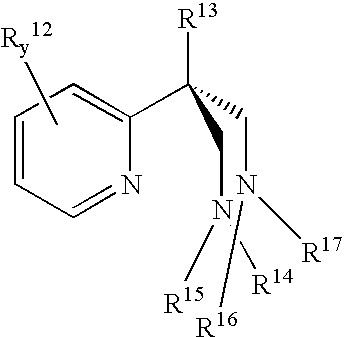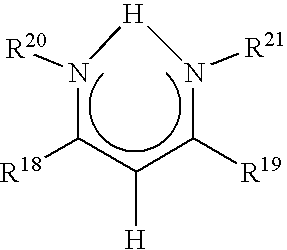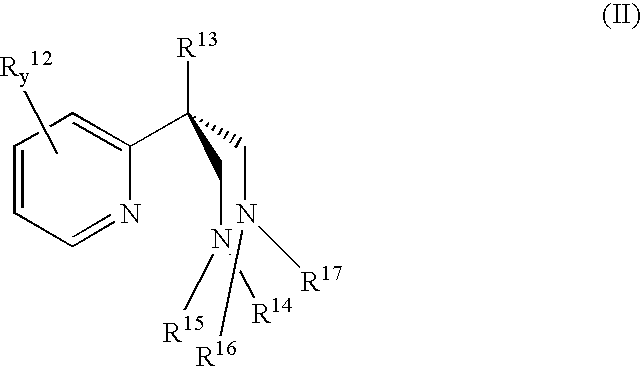Catalyst component for olefin polymerization
a catalyst and alphaolefin technology, applied in catalyst activation/preparation, chemical/physical processes, bulk chemical production, etc., can solve the problems of limited availability and versatility of catalyst precursors, limited commercial applications of catalyst precursors and metallocene-based polymerization processes, and relatively difficult to synthesize metallocene catalyst precursors. , to achieve the effect of improving co-monomer incorporation, low molecular weight distribution, and low conten
- Summary
- Abstract
- Description
- Claims
- Application Information
AI Technical Summary
Benefits of technology
Problems solved by technology
Method used
Image
Examples
example 1
[0063]Synthesis of solid catalyst component. Step (a). A 5 L stainless steel reactor was charged with magnesium powder (32.17 g, 132.34 mmol) under nitrogen. The magnesium was heated at 85° C. for 1 hour, after which hexane (2000 ml) was added. Then iodine (3.33 g), iso-propanol (3.66 ml), and n-chlorobutane (2.8 ml) were successively added to the reaction mixture. After the color of the iodine disappeared, the temperature was cooled down to 75° C., and isoamyl ether (100 ml, 49.16 mmol), tetraethyl orthosilicate (273.8 ml, 1227.52 mmol), were successively added to the reaction mixture over 30 minutes. After temperature was raised to 78° C., titanium (IV) propoxide (22.2 ml, 8.07 mmol) was added to the reaction mixture. Stable reaction took place after n-chlorobutane (213.3 ml) was slowly added over 3.5 hours. The dark reaction mixture formed in the process was stirred for another 2 hours at 80, and another 1 hour at 85° C. The reaction was stopped and the solution was allowed to se...
examples 7 – 13
Examples 7–13
[0076]Solid catalyst components (or precursors) were prepared in the same manner as in Example 1, except that N,N′-di(2,6-diisopropylphenyl)-N,N′-di(tri-methyl-silyl)-α,α′-xylenediamine, N,N′-di(2,6-diisoprocyclohexyl)-N,N′-di(trimethylsilyl)-9,10-phenanthrene-diamine, N,N′-di(2,6-diisopropylphenyl)-2-methyl-2-(2-pyridine)-propane-diamine (diamino-pyridine), and 2-((2,6-diisopropylphenyl)amino)-4-((2,6-diisopropylphenyl)amino)-2-pentene (β-diketimide) were used. The composition of the resulting solid catalyst components was Mg12.5TiCl26.5(OR)0.4Si0.2[diamine]1.3, Mg14.1TiCl27.6(OR)0.3Si0.2[diamine]1.4, Mg12.6TiCl27.1(OR)0.2Si0.2[diamine]1.2, and Mg12.8TiCl26.2(OR)0.2Si0.2[diamine]1.3, respectively. Ti content in the solid catalysts was about 7.0 wt %.
[0077]The co-polymerization was carried out in the same manner as in Example 1. The data show that diamine-based catalysts have a narrower molecular weight distribution and better co-monomer incorporation compared to those ...
example 14
[0079]A solid catalyst component (or precursor) was prepared in the same manner as in Example 1 except that trichloroboron replaced silicon tetrachloride as an activator. Polymerization was carried out in the same manner as in Example 3. 48 g of co-polymer having good powder property was obtained with a density of 0.9037 g / cm3, melting point of 123.2° C. and ΔH=65.7 J / g. The productivity of the catalyst was 3840 g polymer / g catalyst-h-100 psi ethylene, indicating very high catalyst activity. The melt index of the polyethylene was 0.945 g / 10 minutes, measured at 190° C. under a weight of 2.16 kg (ASTM D 1238 Condition E), and the melt flow ration (MFR) was 25.92. The content of xylene-soluble portion was 10.2%. The data shows that catalyst activity, comonomer incorporation, MWD, and the amount of lower molecular weight components (CXS %) are very similar to the solid catalyst precursor with SiCl4 as activator.
PUM
| Property | Measurement | Unit |
|---|---|---|
| molar ratio | aaaaa | aaaaa |
| temperature | aaaaa | aaaaa |
| temperature | aaaaa | aaaaa |
Abstract
Description
Claims
Application Information
 Login to View More
Login to View More - R&D
- Intellectual Property
- Life Sciences
- Materials
- Tech Scout
- Unparalleled Data Quality
- Higher Quality Content
- 60% Fewer Hallucinations
Browse by: Latest US Patents, China's latest patents, Technical Efficacy Thesaurus, Application Domain, Technology Topic, Popular Technical Reports.
© 2025 PatSnap. All rights reserved.Legal|Privacy policy|Modern Slavery Act Transparency Statement|Sitemap|About US| Contact US: help@patsnap.com



